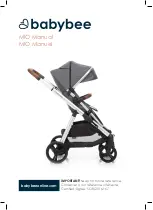
instructions for
starter/charger 800/110amp 12/24V 400V
MoDEL no:
start800
thank you for purchasing a sealey product. manufactured to a high standard, this product will, if used according to these instructions,
and properly maintained, give you years of trouble free performance.
IMPORTANT:
PLEASE READ THESE INSTRUCTIONS CAREFULLY. NOTE THE SAFE OPERATIONAL REQUIREMENTS, WARNINGS & CAUTIONS. USE
THE PRODUCT CORRECTLY AND WITH CARE FOR THE PURPOSE FOR WHICH IT IS INTENDED. FAILURE TO DO SO MAY CAUSE DAMAGE AND/OR
PERSONAL INJURY AND WILL INVALIDATE THE WARRANTY. KEEP THESE INSTRUCTIONS SAFE FOR FUTURE USE.
stArt800 | issue:1 23/06/17
Original Language Version
© Jack sealey Limited
1. saFetY
1.1.
eLectrIcaL saFetY
WarNINg!
it is the responsibility of the owner and the operator to read, understand and comply with the following:
You must check all electrical products, before use, to ensure that they are safe. You must inspect power cables, plugs, sockets and any
other connectors for wear or damage. You must ensure that the risk of electric shock is minimised by the installation of appropriate
safety devices. A residual current circuit Breaker (rccB) should be incorporated in the main distribution board. We also recommend
that a residual current Device (rcD) is used. it is particularly important to use an rcD with portable products that are plugged into
a supply which is not protected by an rccB. if in any doubt consult a qualified electrician. You may obtain a residual current
Device by contacting your sealey dealer.
1.1.1.
You must also read and understand the following instructions concerning electrical safety.
1.1.2.
the
electricity at Work act 1989
requires that all portable electrical appliances, if used on business premises, are tested by a qualified
electrician, using a Portable Appliance tester (PAt), at least once a year.
1.1.3.
the
health & safety at Work act 1974
makes owners of electrical appliances responsible for the safe condition of those appliances
and the safety of the appliance operators.
If in any doubt about electrical safety, contact a qualified electrician.
1.1.4.
Ensure that the insulation on all cables and on the appliance is safe before connecting it to the power supply. see 1.1.1. and 1.1.2. and
use a Portable Appliance tester.
1.1.5.
Ensure that cables are always protected against short circuit and overload.
1.1.6.
regularly inspect power supply leads, plugs for wear and damage and power connections, to ensure that none is loose or damaged.
WarNINg! eLectrIcaL INstaLLatION OF start800 tO a 3 phase 415VOLt sUppLY mUst ONLY Be carrIeD OUt
BY a QUaLIFIeD eLectrIcIaN. make sure the power supply cable is correctly connected to the earth. It is the user’s
responsibility to read, understand and comply with the following:
1.1.7.
this product must be fitted with a 3 phase plug according to the diagram to the right, and will require a minimum of 16amps
per phase, (preferably 32amp) electrical supply. You must contact a qualified
electrician to ensure an appropriately fused
supply is available.
connect greeN/YeLLOW wire to earth ‘e’
connect greY wire to L1 terminal.
connect BrOWN wire to L2 terminal.
connect the BLacK wire to terminal L3.
When completed, check there are no bare wires, that all wires have been connected correctly and
the cable restraint is tight.
8
DO NOt use this product with a standard extension cable. Only use armOUreD extension cable.
cable.
1.2.
geNeraL saFetY
▲
DaNger! Be aWare, LeaD-acID BatterIes geNerate eXpLOsIVe gases DUrINg NOrmaL BatterY OperatION.
FOr thIs reasON, It VerY ImpOrtaNt tO reaD aND FOLLOW these INstrUctIONs careFULLY, each tIme YOU Use
the chargINg eQUIpmeNt.
1.2.1.
follow these instructions and those published by the battery and vehicle manufacturers, and the maker of any equipment you intend to
use in the vicinity of the battery. remember to review warning marks on all products and on engines.
WarNINg!
Modern vehicles contain extensive electronic systems.
You are required to check with the vehicle Manufacturer, for any specific instructions regarding the use of this type of equipment on
each vehicle.
1.2.2.
no liability will be accepted for damage / injury, where this product is not used in accordance with all instructions.
1.3.
personal precautions
9
Ensure there is another person within hearing range of your voice and close enough to come to your aid, should a problem arise when
working near a lead-acid battery.
9
Wear safety eye protection and protective clothing. Avoid touching eyes while working near battery.
Wear
Protective
Gloves
Warning:
Electricity
Protect
from
rain
use in
well
ventilated
areas
Keep away
from sources
of ignition:
battery could
explode
refer to
instruction
manual
Warning:
explosive
material
Wear eye
protection
Warning:
corrosive
substance






















